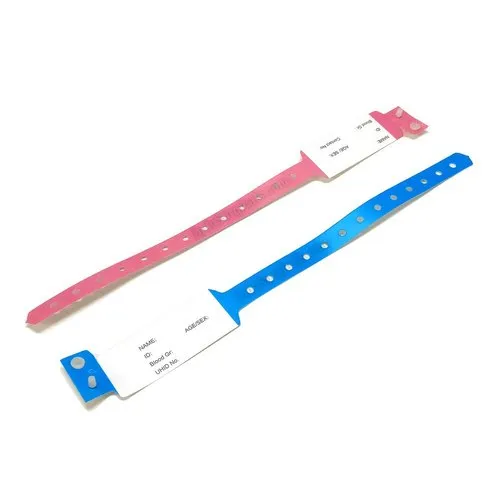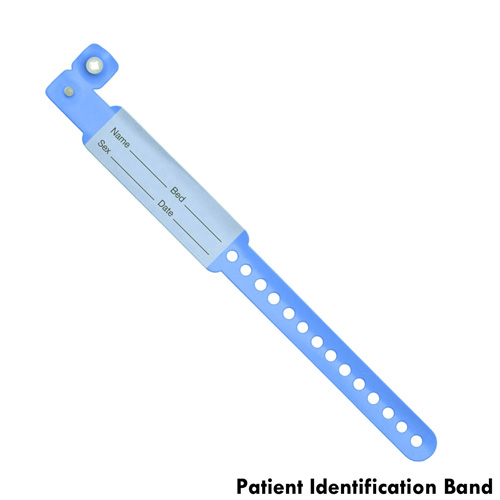Individual Recognition Bands: A Trick Device for Improved Medical Accuracy
Client identification bands represent an important part in the quest of clinical precision and person safety and security within healthcare environments. The real extent of their influence on patient outcomes and total healthcare top quality warrants further assessment.

Relevance of Person Recognition
Person identification is a crucial part of medical care that makes sure the security and accuracy of medical therapy. Appropriate identification procedures are necessary to stop clinical mistakes, which can result in adverse patient outcomes, including wrong medication administration, misdiagnosis, or improper therapy plans. The value of exact patient identification can not be overstated, as it functions as the structure for effective interaction amongst medical care service providers.
In atmospheres where several clients are getting treatment concurrently, the threat of identity confusion boosts. Applying robust identification systems aids alleviate these risks and boosts patient safety. Patient Identification Band. In addition, accurate recognition contributes to the stability of medical records, ensuring that client histories, allergies, and previous treatments are correctly connected to the appropriate individual.
In addition, compliance with governing standards and certification requirements often mandates rigorous person identification methods, cultivating a culture of liability and top quality care. Inevitably, the value of client identification transcends plain management tasks; it is a fundamental facet of supplying top quality health care that prioritizes person safety and security and boosts medical results. Investing in efficient recognition practices is not just useful-- it's critical in today's facility healthcare landscape.
Kinds Of Patient Recognition Bands
In medical care settings, numerous sorts of individual identification bands are used to ensure precise identification and enhance security. These bands work as a crucial tool in stopping clinical errors connected to patient misidentification.
One of the most usual kind is the typical wristband, generally constructed from durable plastic and published with the person's name, day of birth, and an unique recognition number. These wristbands are usually color-coded to convey specific information, such as allergic reactions or various other clinical conditions.
Another type is the barcode wristband, which integrates a scannable barcode linked to the client's electronic wellness record. This innovation permits effective data access and verification throughout medication administration and other professional procedures.
In Addition, RFID (Radio Frequency Recognition) bands are becoming progressively popular. These bands can communicate wirelessly with health center systems, permitting for real-time tracking and recognition of patients, thereby boosting and simplifying process person security.

Advantages for Doctor
Utilizing patient identification bands supplies significant benefits for healthcare providers, boosting both functional effectiveness and person safety. These bands work as an essential tool in streamlining client administration procedures (Patient Identification Band). By making sure exact identification, doctor can reduce the risk of management errors, such as mislabeling examples or misdirecting therapies, which can bring about expensive hold-ups and difficulties
Furthermore, person identification bands help with smooth communication among the health care team. With standard and conveniently obtainable client details, suppliers can make informed decisions promptly, boosting total operations. This efficiency is specifically important in high-pressure settings such as emergency departments, where time-sensitive treatments are important.
The implementation of identification bands likewise sustains conformity with regulative requirements and finest methods, consequently decreasing the danger of lawful repercussions stemming from recognition mistakes. Additionally, using these bands improves information accuracy in electronic health and wellness documents, leading to better care sychronisation and continuity.
Effect On Patient Safety And Security
Exact individual identification is a keystone of medical care security, considerably reducing the chance of mistakes that can endanger person health. Using individual identification bands is essential in ensuring that each patient receives the proper therapy, drugs, and treatments. These bands act as a trusted recommendation factor for healthcare experts, reducing the threat of misidentification, which can result in significant repercussions such as inaccurate drug administration or surgical errors.
The execution of standard patient recognition bands contributes to a culture of security within medical care setups. By offering clear, conveniently legible information, these bands assistance from this source to enhance the relevance of validating person identity at every stage of treatment. Furthermore, they promote communication among team member, guaranteeing that everybody associated with a client's treatment understands their particular requirements and demands.
In enhancement, making use of patient recognition bands can improve the precision of digital health documents, further lowering the potential for mistakes - Patient Identification Band. By prioritizing individual safety with effective identification methods, health care companies can cultivate trust and confidence among people, eventually bring about better medical end results and improved individual fulfillment. The influence of correct patient recognition can not be overemphasized; it is a basic element of premium medical care delivery
Best Practices for Application
Effective execution of person identification bands is essential for improving patient safety and minimizing errors in healthcare settings. Personnel training is important; all team participants need to recognize the significance of accurate individual identification and the treatments for band application.
2nd, the style of the identification bands must prioritize presence and toughness. Bands should be very easy to review, consist of vital patient details, and stand up to daily wear. Using color-coding can further boost quick recognition.


Third, incorporating electronic health documents (EHR) with identification band systems can enhance workflow. Automated notifies for discrepancies in client identification can protect against possible errors prior to they happen.
Last but not least, performing normal audits and feedback sessions learn this here now will help identify areas for enhancement. Engaging personnel in these discussions promotes a culture of safety and security and responsibility.
Verdict
To conclude, client identification bands play a crucial duty in improving clinical accuracy and making sure client safety and security within healthcare systems. By utilizing numerous sorts of recognition bands, healthcare suppliers can dramatically minimize the danger of misdiagnoses and medicine errors. The assimilation of advanced innovations, such as rfid and barcodes, better maximizes data management and tracking. Taking on finest methods for implementation promotes a culture of security, inevitably bring about enhanced person outcomes and greater count on medical care solutions.
Client recognition bands stand for a critical component in the quest of clinical precision and individual security within health care settings.Using individual identification bands offers significant benefits for healthcare carriers, boosting both operational efficiency and patient safety and security. By focusing on individual safety through reliable recognition practices, healthcare carriers can cultivate count on and self-confidence amongst individuals, ultimately leading to far better scientific results and improved individual complete satisfaction.Effective execution of client identification bands is critical i was reading this for improving patient security and minimizing mistakes in health care setups.In final thought, person identification bands play an essential duty in boosting clinical accuracy and making sure client safety and security within healthcare systems.